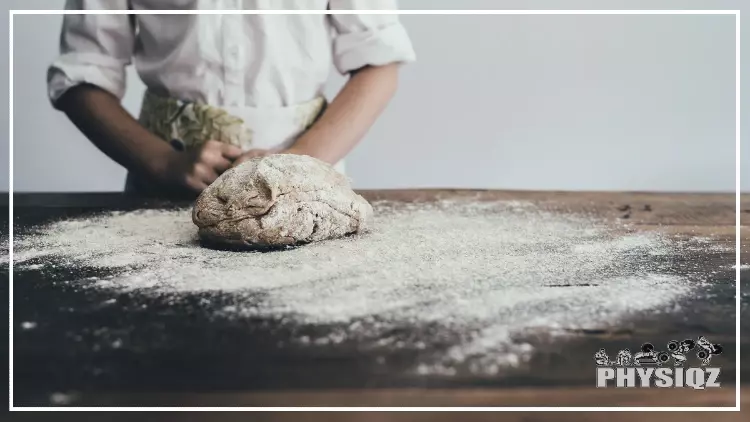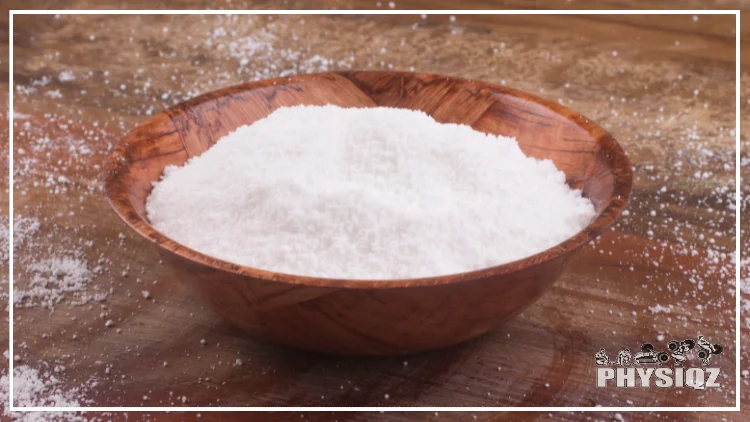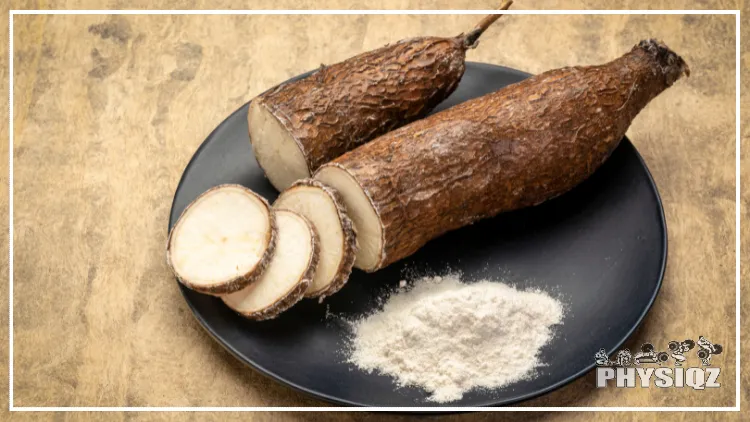
There may be some questions if tapioca flour is keto friendly. Unfortunately, when the proper version of tapioca flour is not purchased, this 1 low carb flour mistake can ruin ketosis.
In all fairness, tapioca flour is made from a specific root that also makes up two other types of flour, so it can be quite confusing when trying to determine which flour to buy. Through this article, an understanding will be garnered of what tapioca flour is, what a keto alternative to it is, and a keto bread recipe with just 1 net carb per slice.
What Is Tapioca?
Tapioca is a starch that is extracted from the cassava root. It is often ground into a powder and used in baking or as a thickening agent.
To create tapioca flour, cassava root is skinned, crushed, and dried to leave what looks like normal flour, but tapioca flour. Tapioca typically has little to no taste and is used in scenarios similar to cornstarch, primarily as a thickening agent in stews and desserts. But in recent years, it has been used more and more in various processed foods like chips and crackers.

Source: rodrigobark via Canva.com1
It is easily digestible due to being made out of cassava root, making it viable for various diets like whole food, paleo, and gluten-free.
While tapioca flour can be part of a keto diet, it is important to purchase the right type of flour. When choosing a tapioca flour, make sure to select one that is 100% tapioca starch. Some brands of tapioca flour also contain wheat or other types of flour, which will add carbs and potentially sugar to the product.
If anybody is thinking whether tapioca is keto, when using a certain brand of tapioca flour, it is best to contact the manufacturer directly. They should be able to provide information on the carb and sugar content of their product.
When used in moderation, tapioca flour can be a great addition to a keto diet. However, it is important to keep track of the carbs and sugar that are consumed when eating foods made with this flour. By doing so, falling out of ketosis can be avoided.
Is Tapioca Flour Ketogenic?
The ketogenic diet is a high-fat, low-carbohydrate diet that has been shown to promote weight loss and improve overall cardiovascular health. If you’re curious about losing weight in 7 days or need tips on distracting yourself from hunger, keto might be the solution for you. However, there are a few principles to keep in mind when on it.
When following the keto diet, it is important to avoid foods that are high in carbs and sugar. The ketogenic diet is contingent upon consuming primarily fats and protein to allow for ketones to act as the primary fuel source, as opposed to glucose, which tends to be created when consuming lots of carbs.2
That being said, tapioca flour is a type of flour that is made from cassava root. While it does not contain any wheat or other types of flour, it is quite high in carbs. For this reason, tapioca flour is not considered to be keto-friendly.
If a person is following the keto diet, it is best to avoid foods that are made with this flour as one of the main ingredients. However, if it is used in minimal amounts, it may not knock a person out of ketosis, but it is still a risk.
When Is Tapioca Flour Keto-Friendly?
Dried tapioca pearls, according to the U.S. Department of Agriculture, contain the following nutrients per 100 grams of dried tapioca:3
- Calories: 358
- Protein: 0 grams
- Fat: 0 grams
- Carbohydrates: 89 grams
- Fiber: 1 gram
- Net carbs: 88 grams
There are some instances when tapioca flour can be used in a keto-friendly way. If a person is making a dish that requires a thickening agent, such as a stew or soup, a small amount of tapioca flour can be used. But because essentially all of the calories from tapioca flour come from carbohydrates, an extremely small amount should be used.
So, to answer the question if tapioca flour is keto friendly: if a person is following a strict keto diet, it is best to avoid tapioca flour altogether. But, if a person truly wants or needs to consume tapioca due to their diet or for another reason, there is an easier way: purchase soluble tapioca.
Soluble Tapioca vs Tapioca Starch
So far, this article has only discussed the macronutrient profile of tapioca flour that comes from standard tapioca starch. Tapioca starch is far less refined an ingredient than soluble tapioca, which can be consumed in larger quantities on the keto diet.
Soluble tapioca starch can frequently be seen in the ingredient list for protein or keto foods like:
- Protein bars
- Keto or low-sugar candy
- Keto ice cream
- Keto chocolate
It tends to appear on the ingredients list under a few different pseudonyms including:
- Soluble vegetable fiber
- Soluble fiber from tapioca
- Resistant dextrin
- Digestion resistant dextrin
- Soluble tapioca fiber
Soluble tapioca starch is created from non-GMO tapioca starch and is primarily used as a sweetener and dietary fiber supplement. It has no glycemic impact, unlike regular tapioca starch, 1 net carb per serving, and promotes an overall healthy gut microbiome due to the dietary fiber comprising the majority of the calories.4,5
The important thing to note here is that while tapioca flour is frequently included in recipes for bread, pasta, and crackers, soluble tapioca fiber is traditionally found in small quantities where it acts as supplemental fiber and as a non-nutritive sweetener. Given the high fiber content in soluble tapioca starch, it could be advantageous to include it in a 3-day cleanse to lose belly fat.
How Many Are Carbs In Tapioca Flour?
As aforementioned, there are 89 grams of carbohydrates per 100 grams of dried tapioca. This means that on the keto diet, to stay in ketosis, a person would need to consume less than 20 grams of dried tapioca to ensure that their blood sugar levels do not spike or that they do not consume more than 20 grams of net carbs.
To reiterate the answer to the main question, it is quite clear that consuming normal tapioca flour is a mistake that will ruin keto.

Source: Luis Echeverri Urrea via Canva.com6
Soluble tapioca starch, on the other hand, has 86 grams of carbs per 100 grams, but also has 72 grams of fiber, meaning 100 grams of soluble tapioca fiber only has 14 net carbs. Combined with the fact that it is not reported to affect blood sugar levels in the slightest, this affirms that soluble tapioca is safe for a keto dieter to eat.
This method is also effective for attaining a calorie deficit without exercise; the abundance of fiber helps reduce overall satiety levels, resulting in fewer food cravings.
Tapioca Flour: Keto Bread Recipe
Ingredients:
- 1/2 cup coconut flour
- 1/3 cup soluble tapioca starch
- 4 tbsp flax seed
- 1 tbsp baking powder
- 1 tsp xanthan gum (optional, for thickening)
- 5 eggs
- 1/4 cup olive oil (extra virgin preferred)
- 1 overripe banana, mashed
- 1/4 cup heavy cream
- 1/4 cup whole milk
- 1 tsp ground cinnamon
- 1/2 tsp nutmeg
- 1/2 tsp sea salt
Instructions
- Preheat your oven to 375 degrees Fahrenheit and grease a glass or metal bread loaf tin.
- Combine coconut flour, tapioca starch, flax seed, baking powder, xanthan gum, salt, cinnamon, and nutmeg and pulse in a food processor to blend.
- In a separate bowl, whisk the eggs together with the olive oil, banana, heavy cream, and whole milk.
- Once thoroughly mixed, pour the wet mixture into the dry and whisk until an even consistency is achieved.
- Pour into the bread loaf tin, gently tapping the tin on your counter afterward to ensure there are no air bubbles.
- Put into oven for 30 minutes.
- At this time, test the bread with a toothpick to see how much longer it needs to cook, adding in 5-minute increments until the toothpick comes out clean. (NOTE: If the top is getting too brown, place some tinfoil over top of it.)
- Remove the loaf pan from the oven, let it cool for 30 minutes, then remove the bread from the pan and store it in an airtight container.
This low-carb keto bread makes about 10 slices of bread. It is subtly sweet from the soluble tapioca starch and is also quite filling due to the macronutrient makeup. The vast majority of calories come from fats and fiber – eggs, nuts, soluble tapioca – so for most people, one slice of bread is more than enough.
The best part is, this recipe only contains 1 net carb per slice of bread. Technically, if a person was really hungry, they could eat this entire loaf of bread and still have half of their daily allotted net carb intake available to them.
Is Cassava Flour & Tapioca Flour The Same?
The cassava plant originally comes from South America. In order to make cassava and tapioca flour, the cassava root is ground down in different ways. While cassava flour is created using the entire root, tapioca flour only uses the pulp found inside of the root.
Both flours are gluten-free, but when the entire cassava root is ground down into cassava flour, there is still some water content that dilutes the starch. This means that tapioca flour has a higher starch content than cassava flour.
Tapioca flour is frequently used in baking because, esoterically, many people remark that it creates very crisp crusts. It can also be used as a thickener similar to cornstarch, thickening things like stews and gravies, while cassava flour is typically used in other types of dishes like pastries and doughs.
So, while cassava flour and tapioca flour come from the same plant, they are not the same thing. Cassava flour is coarser and has a lower starch content than tapioca flour.
Cassava Flour: Is It Keto-Friendly?
For those on the ketogenic diet, consuming cassava flour is likely out of the question and thus is not keto approved unless eaten in very small quantities. Cassava flour contains a lot of carbohydrates that appear as the sugars glucose and fructose. These can lead to complications in keto dieters as these carbs spike blood sugar significantly.

Source: marekuliasz via Canva.com7
However, dissimilar to tapioca flour, cassava flour contains dietary fiber which slightly negates the blood sugar spiking effects of the sugars. In addition, cassava flour offers a well rounded profile of nutrients including vitamin B6, magnesium, and potassium.
Is Cassava Starch Ketogenic?
While cassava flour may have some health benefits, it is not keto-friendly due to its high carbohydrate content. This is quite similar to the issue with tapioca flour, where there are some nutritional benefits and vitamins inside the flour, but nearly all of the calories come from non-fiber carbs. If someone is looking for a low-carb alternative to wheat flour, soluble tapioca flour or almond flour would be better choices.
Summary
Tapioca flour comes from the pulp of the cassava root and is quite high in carbohydrates, while also being quite low in fats, protein, and fiber. This makes it a poor option for a keto diet; soluble tapioca flour, on the other hand, is mainly composed of dietary fiber, which makes it a better version of tapioca flour to have on the keto diet. Cassava flour, similar to tapioca flour, is not that good for the keto diet due to its high carbohydrate count.
So, for those people wondering if tapioca flour is keto-friendly, the answer is in general, no, but soluble tapioca flour can act as a non-nutritive fiber-filled sweetener.
References
1rodrigobark. Canva. Accessed 15 April 2023. <https://www.canva.com/photos/MADIV9AVv0s-tapioca-manioc-flour-in-a-bowl/>
2Masood, W., Annamraju, P., & Uppaluri, K. R. (n.d.). Ketogenic Diet. StatPearls Publishing. <https://pubmed.ncbi.nlm.nih.gov/29763005/>
3U.S. Department of Agriculture. (2022). FoodData Central Search Results. FoodData Central. Retrieved November 9, 2022, from <https://fdc.nal.usda.gov/fdc-app.html#/food-details/169717/nutrients>
4Livesey, G., & Tagami, H. (2009). Interventions to lower the glycemic response to carbohydrate foods with a low-viscosity fiber (resistant maltodextrin): meta-analysis of randomized controlled trials. The American Journal of Clinical Nutrition, 89(1), 114-25. <https://pubmed.ncbi.nlm.nih.gov/19126874/>
5Gibson, G. R., Hutkins, R., Sanders, M. E., Prescott, S. L., Reimer, R. A., Salminen, S. J., Scott, K., Stanton, C., Swanson, K. S., Cani, P. D., Verbeke, K., & Reid, G. (2017). Expert consensus document: The International Scientific Association for Probiotics and Prebiotics (ISAPP) consensus statement on the definition and scope of prebiotics. Nature Reviews Gastroenterology & Hepatology, 14(8), 491-502. <https://pubmed.ncbi.nlm.nih.gov/28611480/>
6Urrea, Luis Echeverri. Canva. Accessed 15 April 2023. <https://www.canva.com/photos/MADVRHyYyxw-manioc-tapioca-flour-in-a-bowl-manihot-esculenta/>
7marekuliasz. Canva. Accessed 15 April 2023. <https://www.canva.com/photos/MADm58HExsA-yuca-cassava-root-and-flour/>